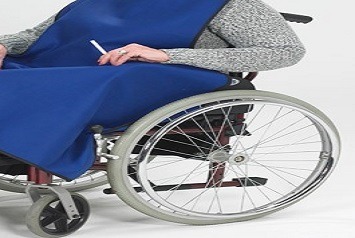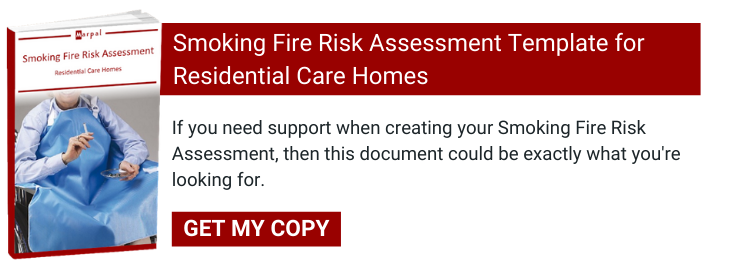
Within Residential Care Homes adequate precautions need to be in place to ensure that residents who smoke do so without putting themselves or others at risk from fire.
There have been a number of recent fire incidents within the Care Sector which have been attributed to residents who smoke. If Care Homes have in place comprehensive and robust policies, procedures, risk assessment templates etc, they can reduce the risk of injury/loss of life and also protect themselves from prosecution and litigation.
When assessing the risks associated with smoking, Care Home Groups and their Managers will need to consider the physical arrangements that are in place (or that need to be put in place), the care needs/medical condition of the specific residents who smoke and the management systems that are in place, or need to be put in to place.
Based on the following guidance Marpal have produced a Smoking Fire Risk Assessment template for Home Managers to use.
Physical arrangements within the Home
Whilst becoming increasingly rare, some Care Homes have internal ‘smoking rooms’. Internal rooms are higher risk as any fire incident could fill the room with smoke, unlike external smoking areas where the smoke disperses into the atmosphere.
Physical issues to be considered within designated internal and external smoking areas for residents should include:-
- The type of chairs provided – Chairs with enclosed side arms should be avoided as any dropped cigarettes, lighters etc. could become trapped between the resident and the chair, resulting in the residents clothes becoming ignited. Chairs also need to be in good condition, only the outer fabric of modern chairs is ignition resistant, the internal material is usually flammable.
- Consider the use of ‘Ciglow’ or a similar wall mounted flameless cigarette lighting device to remove the need for residents to have their own cigarette lighters/matches.
- If cigarette lighters are used, staff should check their condition (cracked/damaged ones should be discarded).
- External smoking area; Has timber decking been used? If so, the boards should be tightly butted up to each other, to avoid gaps through which lit cigarettes could pass and potentially ignite dry leaves or similar below the deck.
- Are both internal and external smoking areas suitably ventilated? (internal areas require mechanical ventilation, if external, they should be open on at least 3 sides).
- Is a suitable metal receptacle for the disposal of waste material provided and is a member of staff tasked with ensuring that waste material from smoking areas is removed regularly?
- Is there any evidence of burn marks on the floor or furniture that may suggest persons using the facility are not competent to smoke safely?
- Does the resident have an airflow mattress? (if there is a risk, or history of illicit smoking within their bedroom, staff should be aware, that in the event of a fire involving one of these mattresses, the air flow continues and ‘fans the flames’).
- Is there a carbon dioxide fire extinguisher in the immediate vicinity of the smoking area?
- Is the area clear of other combustible items e.g. combustible wall linings such as curtains, stored goods, leaves etc.?
- Is the area visible by staff and can a resident who is not supervised call for staff assistance? (smoking areas should be adjacent to areas of the Home where there are usually staff present).
- Consider the combustibility of materials within the smoking residents’ bedroom e.g. the residents personal possessions, bedding/throws, curtains, waste paper bin, nightwear etc. This is of particular importance where there is a risk of, or a known history of illicit smoking within their bedroom.
- The location of LPG storage tanks and refuse areas (the smoking area should be away from LPG tanks in case of gas leakage).
- If residents use e-cigarettes, ensure that the devices are CE marked, staff should monitor the battery charging arrangements and that only compatible devices are used. This will reduce the risk of overheating/battery ignition.
Resident’s care/medical needs to consider
The physical and mental health of the resident who smokes will contribute greatly to the risk profile assigned to the resident. Able bodied residents with little or no neurological or medical impairment/s are not usually found within Care Homes, therefore, the Home Manager should always consider at admission and on a regular basis thereafter, factors such as:-
- Whether or not residents uses oxygen/receives oxygen therapy. Oxygen can cling to the clothes of both the resident and staff and can result in a rapid ignition of the clothing and a heightened fire intensity. All residents and staff members who come in to contact with oxygen should brush down their clothing before smoking.
- Whether or not the resident is the wheelchair user (wheelchair users cannot stand up quickly to brush off any dropped cigarettes or lighting materials).
- The residents physical and neurological state of health, e.g. if the resident has previously suffered from or is prone to seizures, strokes, a heart condition, epilepsy, narcosis, suffers from Parkinson’s disease, forgetfulness, muscle weakness, lack of smell, sight impairment etc.
- Consider whether or not a residents’ medication is likely to affect their competency.
- In some cases, whether or not the resident has a history of deliberate fire raising attention seeking behaviour.
- Should a resident’s health deteriorate and the resident consequentially become less able to make their way to a designated smoking area, are they likely to smoke within their bedroom?
- If the resident uses paraffin/petroleum based emollient creams, which can build up on both the skin and clothing.
Control measures that can be put in to place
Some fires at Care Homes are foreseeable and are therefore avoidable. Some recent fire incidents have included residents using emollient creams; this risk has been identified by the NHS and within Fire Authority’s bulletins for many years, yet there continues to be fatalities attributed to the use of these creams. To reduce the risk of avoidable fires, Care Homes should consider the buildings’ physical issues and the residents’ needs as outlined above and should also consider:-
- Providing support for residents who wish to stop smoking.
- If residents are not deemed competent/safe to smoke alone, provide staff supervision and/or assistance whilst residents are smoking.
- Looking out for signs of near misses such as burnt fingers, cigarette holes in clothing, burn marks on floors and or furniture (including where e-cigs are charged).
- The provision of fire retardant smoking apron or blankets.
- Controlling of the residents’ cigarettes and lighting material.
- Considering the provision of a Cig-Arrête smoke detector within the residents’ bedroom.
- Ensure that residents use a suitable means of lighting the cigarette, e.g. not matches or refillable lighters (the re-filling process could result in leakage and necessitates the storage of refill canisters).
- Remove the need for staff/residents to use ‘traditional’ cigarette lighters by using ‘Ciglow’ or similar wall mounted flameless cigarette lighting devices.
- Ensure that staff report any suspected non-compliance with smoking policy e.g. the smell of smoke within non designated smoking rooms, waste smoking material within residents waste paper bins or outside windows, burn marks on window cills etc.
- Ensure waste material from designated smoking areas is removed regularly.
- Display a no smoking sign at the entrance point in to the building.
Enforcement of the Smoking Policy
Where residents are not adhering to the Homes smoking policy/arrangements, the Home Manager should consider:-
- If the resident is able to understand and retain information, explain the smoking arrangements/policies in place at the Home and the fire risk associated with smoking.
- Put in to place increased supervision and raise staff awareness of the issue.
- Arrange for staff to retain smokers’ materials and ensure that visitors are aware not to supply the resident with further materials.
- If the resident continues to smoke in non-designated area, or refuses supervision or similar control measures, the matter should be referred to more senior personnel such as an Area Manager or Head Office.
- In extreme cases where the resident is putting either themselves or others at significant risk of harm, they may need to be moved to a more appropriate facility.
Conclusion
Wherever there is a resident within a Care Home who smokes, a specific Smoking Fire Risk Assessment should be carried out for each and every individual resident, which considers all of the above issues. Each assessment should be reviewed regularly to recognise changes in the residents’ health, physical environment or at a recommended maximum six monthly interval.
Smoking Fire Risk Assessment Templates
Marpal have developed an easy to use template with pre-loaded drop down text options to enable the assessments to be completed relatively quickly.
General
The information given above is for general information purposes only and considers the authors own experience whilst providing fire safety advice within the Care Sector and by reference to information available on the subject matter. Notwithstanding the above, there may be other issues to consider that are not identified within this document.
Posted by: Adrian Gouldin Bsc (Hons) MRICS GIFireE, Marpal’s Head of Fire Safety & IFE registered Fire Risk Assessor.
For further information on Fire Safety, please contact Adrian Gouldin by phone (01332 668877) or email ([email protected]).



